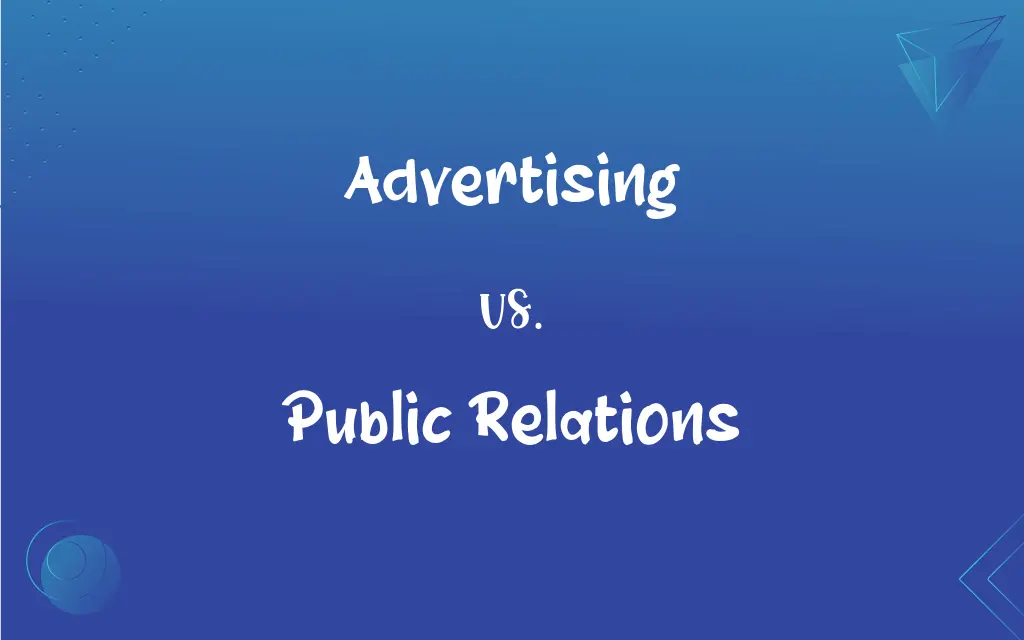Advertising vs. Public Relations: What's the Difference?
Edited by Janet White || By Harlon Moss || Published on November 18, 2023
Advertising promotes products or services, while propaganda spreads ideas or beliefs, often with a political or ideological bias.

Key Differences
Advertising and propaganda are both tools of communication that aim to influence an audience. Advertising seeks to persuade consumers to purchase or engage with a product, service, or brand. It focuses on showcasing the benefits, features, or values of what's being advertised. Propaganda, on the other hand, is more concerned with spreading certain ideas, beliefs, or doctrines, often with an underlying agenda, which might be political, social, or ideological in nature.
While both advertising and propaganda utilize similar techniques like imagery, repetition, and emotional appeal, their primary objectives differ. Advertising aims to generate sales and foster brand loyalty. Its success can often be measured through tangible metrics like increased revenue or market share. Propaganda, conversely, focuses on shaping public opinion or perception about a particular cause or viewpoint, and its impact might be more qualitative and harder to measure.
Ethical considerations often come into play when distinguishing between advertising and propaganda. Good advertising is generally transparent about its intentions, making it clear that its goal is to promote a product or service. Propaganda can sometimes employ deceptive tactics, manipulating facts or presenting biased information to further its agenda and sway public opinion.
Another key distinction lies in the regulatory environment. Advertising, especially in sectors like healthcare or finance, is often subject to strict regulations to ensure truthfulness and transparency. Propaganda, given its often nebulous nature, is harder to regulate, especially when it's cloaked as unbiased information or news.
In summary, while advertising and propaganda share similarities in their approach to influencing audiences, they differ in their core objectives, ethical considerations, and regulatory environments. Advertising is more commercial and transparent, whereas propaganda aims to subtly mold opinions and beliefs.
ADVERTISEMENT
Comparison Chart
Primary Objective
Promotes products, services, or brands.
Spreads ideas, beliefs, or doctrines, often with a bias.
Measurement of Success
Increased sales, brand recognition, market share.
Shaped public opinion, acceptance of certain beliefs.
Ethical Considerations
Should be transparent and truthful about its intent.
May use deceptive tactics or biased information.
Regulatory Environment
Often subject to strict regulations for truthfulness.
Harder to regulate, especially when presented as unbiased information.
Common Techniques
Imagery, repetition, emotional appeal aimed at product benefits.
Imagery, repetition, emotional appeal aimed at instilling certain beliefs or ideologies.
ADVERTISEMENT
Advertising and Public Relations Definitions
Advertising
Publicizing to increase public interest.
The movie's advertising made it a blockbuster.
Public Relations
Information spread to promote a cause or idea.
The government's propaganda painted a rosy picture of the economy.
Advertising
The business of creating ads for clients.
She found her passion in advertising and joined an agency.
Public Relations
Biased or misleading information for persuasion.
Critics argued that the documentary was pure propaganda.
Advertising
A communication strategy to persuade an audience.
Effective advertising speaks directly to consumer needs.
Public Relations
Material disseminated by supporters of a doctrine.
The regime used propaganda to maintain control.
Advertising
The act of promoting goods or services for sale.
The advertising campaign boosted sales by 30%.
Public Relations
A systematic effort to manipulate public opinion.
Propaganda was rife during wartime to boost morale.
Advertising
Messages paid for by sponsors to inform or influence.
The product's advertising was everywhere during the holidays.
Public Relations
Communications aiming to further an agenda.
The propaganda machine was in full swing before the elections.
Advertising
The activity of attracting public attention to a product or business, as by paid announcements in the print, broadcast, or electronic media.
Public Relations
Public relations in attributive use
FAQs
Can advertising contain elements of propaganda?
Yes, if it aims to shape beliefs or values beyond promoting a product, it can have propagandistic elements.
Are there regulations governing advertising?
Yes, many countries have regulations ensuring truthfulness and transparency in advertising.
Why is propaganda often associated with politics?
Propaganda is a tool to shape public opinion, making it useful in political realms to advance agendas.
Can propaganda be positive?
Yes, if it promotes beneficial ideas or truths, but the term often carries negative connotations due to its manipulative uses.
Is all advertising truthful?
While regulations aim to ensure truthfulness, not all advertising is free from exaggeration or bias.
Can a piece of information be both advertising and propaganda?
Yes, if it promotes a product while also pushing a specific belief or ideology.
How can I differentiate between advertising and propaganda?
Examine the intent: advertising generally promotes a product, while propaganda pushes a belief or agenda.
Can news outlets spread propaganda?
Yes, if they present biased or misleading information to shape public opinion.
Do regulations ensure that all advertising is honest?
While regulations aim for honesty, some ads might still be misleading or exaggerated.
Can art be a form of propaganda?
Yes, art can be used to convey specific messages or beliefs, making it a tool for propaganda.
What's the main goal of advertising?
Advertising's primary goal is to promote products, services, or brands to potential consumers.
Is propaganda always misleading?
Not always, but propaganda often presents information with a bias to promote a specific viewpoint.
Can propaganda be found in educational materials?
Yes, if the materials are designed to instill specific beliefs or viewpoints.
How has digital media impacted advertising?
Digital media has expanded the reach and personalization of advertising, making it more targeted.
Why is the line between advertising and propaganda sometimes blurred?
Both aim to influence, and when advertising goes beyond product promotion to push beliefs, it can resemble propaganda.
Why is propaganda hard to regulate?
Due to its often subtle and subjective nature, determining what constitutes propaganda can be challenging.
Are there ethical concerns with propaganda?
Yes, especially if it's deceptive or promotes harmful beliefs.
Is product placement in movies a form of advertising?
Yes, it's a subtle form of advertising where products are integrated into the storyline.
Why is advertising important for businesses?
Advertising helps businesses reach potential customers and communicate the benefits of their offerings.
Are propaganda techniques used in marketing?
Some marketing strategies might use techniques similar to propaganda to shape consumer beliefs.
About Author
Written by
Harlon MossHarlon is a seasoned quality moderator and accomplished content writer for Difference Wiki. An alumnus of the prestigious University of California, he earned his degree in Computer Science. Leveraging his academic background, Harlon brings a meticulous and informed perspective to his work, ensuring content accuracy and excellence.
Edited by
Janet WhiteJanet White has been an esteemed writer and blogger for Difference Wiki. Holding a Master's degree in Science and Medical Journalism from the prestigious Boston University, she has consistently demonstrated her expertise and passion for her field. When she's not immersed in her work, Janet relishes her time exercising, delving into a good book, and cherishing moments with friends and family.






































































